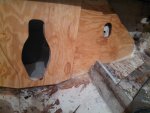Re: Flooding thru transom when in reverse
Transom looks good, but from picture one those stringers look a bit on the dark side. If you want this boat to last for the grandkids i would tripple check those.
Not sure about the voids, but i would think a nice layer of peanut butter would help with that issue.
Transom looks good, but from picture one those stringers look a bit on the dark side. If you want this boat to last for the grandkids i would tripple check those.
Not sure about the voids, but i would think a nice layer of peanut butter would help with that issue.





















